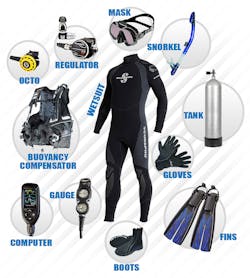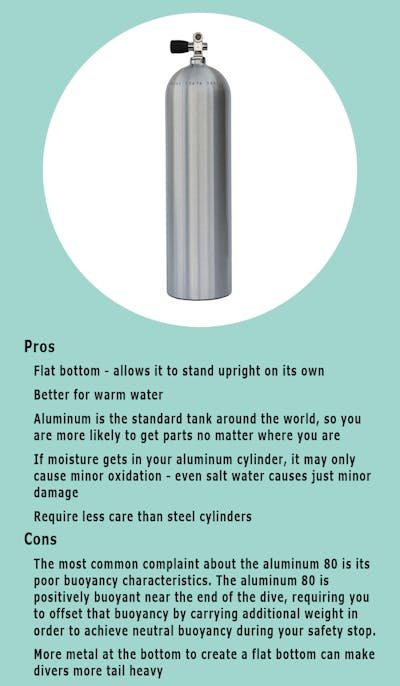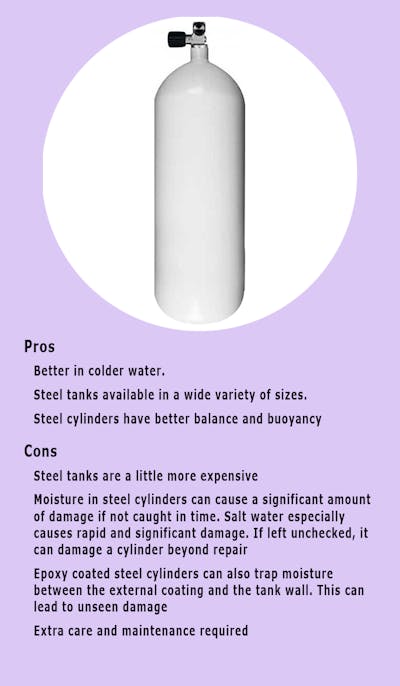Free Shipping on orders of $49+ | Signup for Direct Rewards
Free Shipping on orders of $49+ | Free Store Pickup | Signup for Direct Rewards
Free Shipping on orders of $49+ | Signup for Direct Rewards
Free Shipping on orders of $49+ | Free Store Pickup | Signup for Direct Rewards

Thinking about purchasing your own personal scuba tank, but don’t know where to start looking? Well you’ve come to the right place. Here at Divers Direct we have a variety of different tanks to choose from and experts to help you pick one that’s best for you and your diving needs. Once you’ve decided on the kind of diving you’ll be doing, choosing the right tank is relatively easy. And there is no tank that’s better than the other, only a tank that is the best fit for the type of diving you’ll be doing. Whichever tank is best for you is based on a variety of factors. Dive in below to understand which tank is best for you and why.
First, you must decide if you’re actually ready to buy a scuba tank. Tanks are generally the last thing divers buy. You should first look into purchasing a mask, snorkel, and fins. If you need a wetsuit, and many divers do, purchase one of those too. Then you can look at buying dive computers, BCDs, and regulators since these items are much more custom to you as a diver and you can get more familiar with your unique equipment on every dive you log. Tanks, on the other hand, tend to be quite standard with little variation in recreational diving which is why many divers rent their tanks.
However, when renting tanks, your local dive shop may not have the right size cylinder for you. Additionally, the dive shop may be far and out of the way, causing you an inconvenience when you want to go diving. There is also a certain satisfaction of owning all your own gear and not having to rent anything. So if you’re looking to buy everything all at once, or think it’s the right time for you to purchase a scuba tank, then let’s dive into the next thing to consider.

Now that you’ve decided to purchase a scuba tank of your own, it’s time to decide which tank is right for you. There are two different materials that dive tanks are made of. They can either be made of aluminum or steel. Both aluminum and steel tanks come in a few different sizes. The size of your desired tank will depend on your size, air consumption, and the depth of the diving you’ll be doing.
Aluminum
For the average recreational diver, an aluminum tank is exactly what you need. An aluminum 80 tank will provide the average diver about an hour of air. When empty, it weighs 31 pounds out of the water. Aluminum 80 tanks are roughly 5 pounds of negative buoyancy when full, and neutral to slightly positive buoyancy when empty. This makes it perfect for the average diver because it will help weigh you down during your dive, and allow a slow and controlled ascent when it’s time to surface. If your tank has a positive buoyancy though, you may need to over-weight yourself so you can have neutral buoyancy during your safety stop.
Steel
Once you get into technical and more advanced diving, you may find that steel is the way to go. Steel tanks have rounded bottoms, providing more balanced buoyancy. But they’ll require a tank boot to stand upright. When empty, a steel 80 tank will weigh 28 pounds out of the water. A steel 80 tank has a buoyancy of roughly negative 8 pounds when full, and negative 1.7 pounds when empty. Technical divers are normally horizontal when diving, so many will choose a steel tank for its more balanced buoyancy.


When it comes to choosing aluminum versus steel, the most important thing to consider is the type of diving you’re doing. Do you do a lot of diving in salt water? Then if an aluminum cylinder meets your needs, you may be better off sticking with aluminum. Do you dive mostly in freshwater or need better buoyancy for technical diving? Then you may be better off with a steel cylinder.

Scuba tanks are built in all shapes and sizes. They can be tall and skinny, short and stubby, and flat or round bottomed. Aluminum tanks are flat bottomed and are manufactured to hold anywhere from up to 100 cubic feet of air. Steel tanks are round bottomed and manufactured to hold up to 133 cubic feet of air. However, just because they hold more air, does not mean certain steel tanks are larger or wider than others. Steel tanks have many varying sizes to help cater to every diver. For many women, and shorter individuals, there are shorter tanks that are a bit wider. These tanks help prevent you from bumping your head or butt on the tank while you dive.
The main factor to consider when choosing tank size is your air consumption. If your air consumption typically limits your diving, you may want to invest in a larger tank that can hold more air. The most common scuba tank you’ll see is the aluminum 80, which has a pressure rating of 3,000 psi, or 207 bar. This tank provides adequate bottom time for most divers without substantial risk of exceeding the no decompression limits. Larger divers typically have a higher air consumption, so if you are a larger diver, you may want to invest in a larger tank. Divers that spend more time in deeper water will also want the added safety of a larger tank as well.
When it comes down to it, if you’re looking to purchase a scuba tank, you must first figure out what kind of diving you’re going to do. Once you’ve determined that, finding the right tank will be easy. The most common scuba tank around the world is the aluminum 80 scuba tank. If you ever need your tank serviced, this tank will have the most access to any parts needed around the world. At Divers Direct, we have a wide range of tanks. Both aluminum and steel in many different sizes. If you ever need some more guidance on purchasing a scuba tank, feel free to visit one of our stores, or give us a call. We’re always happy to help.
A typical day of diving involves a two tank dive so it is recommended to get two tanks per person.
You'll need to get a valve inspection (VIP) annually. You'll also need a hydrostatic inspection occasionally, too. Every tank will have a manufacturer’s tag stamped onto the tank with this information. Check this stamp and make sure to have your hydrostatic inspection every 3-5 years.
A scuba tank will not float, in fact when they are filled with air, they will actually have even less buoyancy.
A scuba tank can cost anywhere from $150 to $400+ depending on the size and material of the scuba tank. Steel tanks are typically more expensive than aluminum tanks.
No, recreational divers will fill their scuba tanks with compressed air which typically contains about 20.9% oxygen.
The issue of air expiring has little to do with the air itself, but the moisture that can accumulate in the cylinder. You should not have pressurized air sitting in your tank for more than 3 months.